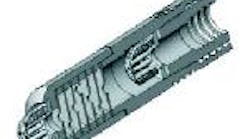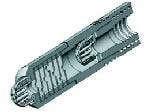The Lee Company has manufactured miniature fluid controls since its inception in 1948. Its capability to miniaturize valves, flow restrictors, solenoid valves, and other subcomponents has been instrumental in reducing the size sand weight of aerospace fluid power systems for decades. Their development of products that withstand system-operating pressures to 8000 psid have contributed to the higher higher power densities of today's aerospace hydraulic systems.
Recently, Lee faced the challenge of reducing the size of one of its standard 0.187-in. diameter flow restrictors, called a Bender Jet. The Bender Jet had been designed into a military aircraft to meter cooling flow to an actuator exposed to high ambient temperatures. Its labyrinthlike series of multiple orifices provides a passage 78% greater than that of a single orifice restrictor with equivalent flow restriction. The Bender Jet's large minimum passages provide higher contamination resistance than a standard orifice, yet reduces the potential for cavitation by reducing fluid velocities through the multiple orifices.
Eventual aircraft performance changes dictated the need for a smaller, lighter actuator assembly that could not accommodate a standard 0.187-in. diameter Bender Jet. These new envelope constraints offered a challenge to the Lee Company's Restrictor Engineering Group.
The restrictor's size had to be reduced by more than a third in order to meet the new actuator envelope constraints. The final design yielded an insert with a diameter of 0.125 in. and an overall length of less than 0.600 in. This was accomplished without any sacrifice in performance and only a 5% reduction in minimum passage area. The redesigned Bender Jet withstands operating pressure differentials to 3500 psid.
For more information on miniature hydraulic components, call (860) 399- 6281 or visit www.theleeco.com


